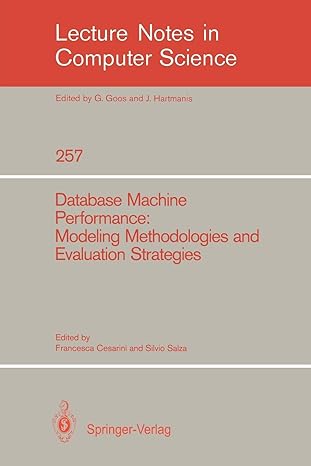Question
In JAVA Please Summary Implement a O(n * log(n)) algorithm of your choice that sorts arrays of objects that extend the Comparable interface. The Comparable
In JAVA Please
Summary
Implement a O(n * log(n)) algorithm of your choice that sorts arrays of objects that extend the Comparable
The Comparable
The Comparable
public interface Comparable{ public int compareTo(T other); }
The method compareTo returns:
a negative number if "this" is considered to be less than "other"
0 if "this" is considered to be equal to "other"
a positive number if "this" is considered to be greater than "other"
For example, the following program would print "-1, 0, 1" (note that Integer extends the Comparable
Integer a = 4; Integer b = 3; System.out.println(b.compareTo(a) + ", " + a.compareTo(a) + ", " + a.compareTo(b));
Generics
The comparable interface is an example of Java's generics feature. We haven't covered generics, but basically it means that the T in Comparable
Inside the sort method, you can use the letter T as if it were the name of whatever type was currently being sorted.
Requirements
Your solution should be in a file called "Sort.java" which contains a method called sort defined as follows:
public class Sort { /** * Method to sort an array of comparable objects. Don't worry too much about this complicated method signature, * it is just some fancy syntax that means it can take an array of any comparable type and that it returns an array of * that same type */ public static > T[] sort(T[] inputArray) { //Student code here } } Whether the code sorts the original array or whether it returns a sorted copy of the original array is up to the student.
You may choose any O(n*log(n)) algorithm that you wish (most likely either merge sort or quick sort) to implement. The only thing you may not do is use any built-in java sorting algorithms.
Example code
Since we've never used any generics before, here is a very basic example of an implementation. In this simplistic example, the solution can only sort arrays of size 2.
public class Sort { public static > T[] sort(T[] array) { if(array.length != 2) { System.out.println("Uh oh! We don't know how to handle this in this silly example"); return null; } if(array[0].compareTo(array[1]) > 0) { T temp = array[1]; array[1] = array[0]; array[0] = temp; } return array; } } For testing purposes, you could call this method with any type that extends the Comparable
String[] strings = {"hello", "World", "how", "are", "you", "today"}; String[] sortedStrings = Sort.sort(strings); Evaluation
The evaluation of the sorting algorithms will be based on unit tests. In order to assert that the sorting algorithm is in fact O(n * log(n)), there will be one test that operates on a fairly large array and checks that the number of comparison operations performed is less than n * log(n) times some reasonable factor. If you believe that your algorithm is in fact within O(n*log(n)) and it does not pass that test, please email me with your justification of why you believe your algorithm is O(n * log(n)) and explain why you are performing more comparisons than expected.
Cannot use the Arrays.sort() function
Step by Step Solution
There are 3 Steps involved in it
Step: 1

Get Instant Access to Expert-Tailored Solutions
See step-by-step solutions with expert insights and AI powered tools for academic success
Step: 2

Step: 3

Ace Your Homework with AI
Get the answers you need in no time with our AI-driven, step-by-step assistance
Get Started


